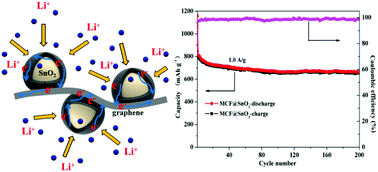Mesoporous graphene/carbon framework embedded with SnO2 nanoparticles as a high-performance anode for lithium storage†
Abstract
The huge volume variation and poor electronic conductivity of tin oxide (SnO2) during the discharge/charge process greatly limit its practical application in lithium ion batteries (LIBs). Hybridization with graphene is a widely-used method to improve its electrochemical performance, but it still faces some limitations. In this work, we integrate carbon encapsulation with graphene hybridization to synthesize a sandwich-like carbon-coated SnO2/graphene composite via a flexible method. In this case, a mesoporous graphene/carbon framework (MCF) derived from acid etching of an as-prepared graphene@Fe3O4@C composite was used as a robust matrix for the embedment of SnO2. When evaluated as an anode material for LIBs, the resultant MCF@SnO2 composite exhibits a high second reversible capacity of 1205 mA h g−1 at 0.2 A g−1, excellent cycling performance with 668 mA h g−1 capacity retention after 200 cycles at 1.0 A g−1, and a good rate capability. This facile strategy could be further extended to embed other metal oxide nanoparticles into the mesoporous carbon framework for applications in energy conversion and storage.



 Please wait while we load your content...
Please wait while we load your content...